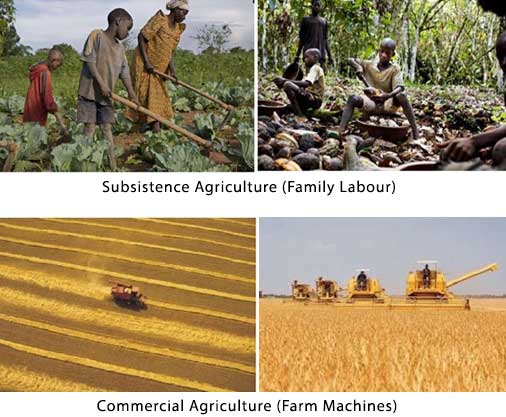A Comprehensive Look at the Challenges and Benefits of Modern Farming
Modern agriculture stands at the crossroads of innovation and sustainability, offering a multitude of possibilities and challenges. The course ahead requires a mindful assessment of these dynamics, welcoming stakeholders to consider the possibility for transformative modification in agricultural methods and policies.
Technical Improvements in Farming
Advancements such as precision biotechnology, agriculture, and automation have changed typical farming methods, allowing for more profitable and lasting procedures. Accuracy agriculture makes use of GPS technology, sensors, and data analytics to optimize field-level management pertaining to crop farming.
Automation in farming has actually even more pushed the sector forward, with the intro of autonomous tractors, drones, and robotics. These technologies minimize labor requirements and boost functional rate, permitting for prompt growing and harvesting. Drones, particularly, offer important airborne imagery and data, assisting farmers in keeping track of crop health and detecting concerns early.
Biotechnology has also played an essential function ahead of time agricultural techniques. Genetically customized microorganisms (GMOs) have been created to improve crop resistance to conditions and bugs, minimize dependence on chemical therapies, and enhance nutritional web content. This innovation contributes to food safety and security and meets the needs of a growing global populace. Collectively, these technological developments have laid the foundation for a more lasting and resilient farming future.
Ecological Obstacles
Farming encounters several ecological difficulties that threaten its sustainability and efficiency. One of the key problems is the deterioration of soil wellness due to extensive farming methods that deplete crucial nutrients and bring about erosion. The overuse of chemical plant foods and pesticides additionally aggravates this concern, polluting water sources and minimizing biodiversity. The long-term stability of agricultural land is jeopardized, necessitating the adoption of even more lasting techniques.
Water shortage is one more substantial obstacle, particularly in areas where agriculture greatly counts on watering. Climate modification is magnifying this issue, altering rainfall patterns and raising the frequency of droughts. Effective water administration systems, such as drip irrigation and rainwater harvesting, are crucial to minimize these effects, however their implementation remains uneven throughout different areas.
Moreover, agriculture is both a factor and a sufferer to climate adjustment. It represents a substantial share of greenhouse gas discharges, largely from livestock manufacturing and rice farming. Transitioning to low-emission farming techniques, such as accuracy farming and agroforestry, can help in reducing this influence. Nevertheless, these approaches call for substantial financial investment and technical know-how, presenting a barrier to extensive adoption. Attending to these ecological challenges is crucial for making certain a lasting farming future.

Economic Effects
The financial influences of modern-day farming are multifaceted and profound, influencing both neighborhood and worldwide markets. Developments in technology and manufacturing approaches have significantly raised agricultural productivity, leading to more reliable food supply chains and minimized costs for consumers.
The capital-intensive nature of modern farming calls for substantial investment in equipment, plant foods, and genetically modified seeds, which can be monetarily challenging for small farmers. Furthermore, international market variations can influence the profitability of agricultural exports, making economies reliant on agriculture prone to economic instability.
Additionally, subsidies and profession policies in established nations can misshape market value, affecting competitive balance and possibly disadvantaging farmers in establishing countries. Overall, while modern-day agriculture drives economic growth, it likewise requires navigating complicated monetary landscapes to make sure equitable and lasting development.
Social Ramifications
While modern-day agriculture has actually brought about significant developments, it likewise presents numerous social effects that require factor to consider. As business farming entities increasingly control the farming landscape, smaller farms often struggle to compete, leading to the erosion of rural areas and typical farming techniques.

Additionally, there are problems concerning food safety and sovereignty. The focus on monoculture and genetically changed plants can undermine biodiversity and make food systems a lot more at risk to bugs and conditions. Such methods could likewise limit consumer options and reduce the capacity of regional communities to control their food resources. As these social effects unravel, it becomes essential to address them to make sure equitable and lasting farming development.
Future Directions
Looking in advance, several appealing avenues for modern-day agriculture can deal with the challenges faced today while promoting lasting development. Advances in innovation, such as accuracy farming, supply the possible to optimize source use and boost effectiveness. By employing data analytics and equipment knowing, farmers can make educated decisions pertaining to crop administration, leading to lowered input expenses and decreased environmental effect. Moreover, the combination of renewable resource resources into farming techniques could substantially decrease reliance on fossil gas and add to reduce greenhouse gas emissions.
Biotechnology likewise holds tremendous guarantee for the future of farming. Genetically modified microorganisms (GMOs) and gene modifying strategies, like CRISPR, might improve plant strength versus environment change, parasites, and diseases, thus improving food safety and security. Diversifying plant selections to include more nutrient-dense and climate-resilient alternatives could strengthen both eco-friendly stability and human nourishment.

Conclusion
Modern agriculture, identified by technological improvements, offers both chances and obstacles. commercial farming vs subsistence farming. Resolving these complexities calls for a change towards lasting practices that stabilize efficiency with environmental stewardship advice and social equity, thus making certain a resilient future for global farming systems.
Modern agriculture stands at the crossroads of innovation and sustainability, presenting a multitude of challenges and possibilities. In addition, global market changes can impact the earnings of agricultural exports, making economies reliant on farming vulnerable to economic instability.
In addition, the intensive usage of innovation and automation in farming has led to a reduction in farming employment chances.Looking in advance, several appealing avenues for modern-day farming can deal with the obstacles faced today while promoting sustainable growth. commercial farming vs subsistence farming.Modern farming, click resources defined by technical innovations, offers both difficulties and chances